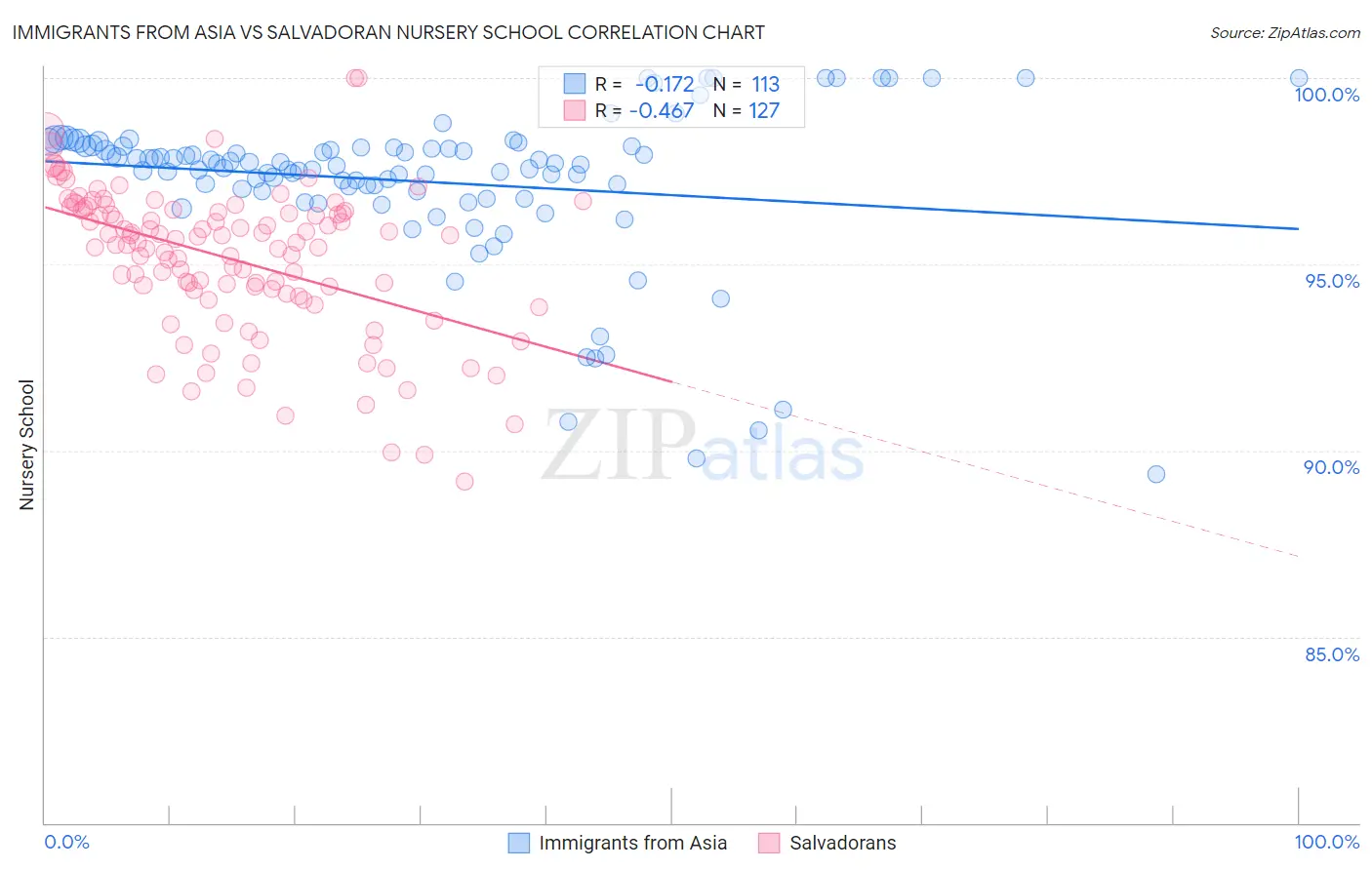Immigrants from Asia vs Salvadoran Nursery School
COMPARE
Immigrants from Asia
Salvadoran
Nursery School
Nursery School Comparison
Immigrants from Asia
Salvadorans
97.6%
NURSERY SCHOOL
0.7/ 100
METRIC RATING
255th/ 347
METRIC RANK
96.4%
NURSERY SCHOOL
0.0/ 100
METRIC RATING
343rd/ 347
METRIC RANK
Immigrants from Asia vs Salvadoran Nursery School Correlation Chart
The statistical analysis conducted on geographies consisting of 549,170,546 people shows a poor negative correlation between the proportion of Immigrants from Asia and percentage of population with at least nursery school education in the United States with a correlation coefficient (R) of -0.172 and weighted average of 97.6%. Similarly, the statistical analysis conducted on geographies consisting of 398,901,064 people shows a moderate negative correlation between the proportion of Salvadorans and percentage of population with at least nursery school education in the United States with a correlation coefficient (R) of -0.467 and weighted average of 96.4%, a difference of 1.3%.

Nursery School Correlation Summary
| Measurement | Immigrants from Asia | Salvadoran |
| Minimum | 89.4% | 89.2% |
| Maximum | 100.0% | 100.0% |
| Range | 10.6% | 10.8% |
| Mean | 97.2% | 95.1% |
| Median | 97.7% | 95.6% |
| Interquartile 25% (IQ1) | 97.0% | 94.2% |
| Interquartile 75% (IQ3) | 98.2% | 96.4% |
| Interquartile Range (IQR) | 1.2% | 2.3% |
| Standard Deviation (Sample) | 2.1% | 2.0% |
| Standard Deviation (Population) | 2.1% | 2.0% |
Similar Demographics by Nursery School
Demographics Similar to Immigrants from Asia by Nursery School
In terms of nursery school, the demographic groups most similar to Immigrants from Asia are Immigrants from Congo (97.6%, a difference of 0.0%), Ethiopian (97.6%, a difference of 0.010%), Immigrants from Africa (97.6%, a difference of 0.010%), Immigrants from Iraq (97.6%, a difference of 0.010%), and Yaqui (97.6%, a difference of 0.010%).
| Demographics | Rating | Rank | Nursery School |
| Indians (Asian) | 0.9 /100 | #248 | Tragic 97.6% |
| Immigrants | Eastern Africa | 0.9 /100 | #249 | Tragic 97.6% |
| Immigrants | Senegal | 0.9 /100 | #250 | Tragic 97.6% |
| Ethiopians | 0.8 /100 | #251 | Tragic 97.6% |
| Immigrants | Africa | 0.8 /100 | #252 | Tragic 97.6% |
| Immigrants | Iraq | 0.7 /100 | #253 | Tragic 97.6% |
| Immigrants | Congo | 0.7 /100 | #254 | Tragic 97.6% |
| Immigrants | Asia | 0.7 /100 | #255 | Tragic 97.6% |
| Yaqui | 0.6 /100 | #256 | Tragic 97.6% |
| Immigrants | Colombia | 0.6 /100 | #257 | Tragic 97.6% |
| Jamaicans | 0.6 /100 | #258 | Tragic 97.6% |
| Armenians | 0.4 /100 | #259 | Tragic 97.6% |
| Immigrants | South America | 0.4 /100 | #260 | Tragic 97.6% |
| Cubans | 0.4 /100 | #261 | Tragic 97.6% |
| Immigrants | Ethiopia | 0.4 /100 | #262 | Tragic 97.6% |
Demographics Similar to Salvadorans by Nursery School
In terms of nursery school, the demographic groups most similar to Salvadorans are Immigrants from Mexico (96.4%, a difference of 0.030%), Immigrants from Cabo Verde (96.4%, a difference of 0.040%), Immigrants from Central America (96.4%, a difference of 0.060%), Immigrants from Guatemala (96.4%, a difference of 0.090%), and Immigrants from El Salvador (96.2%, a difference of 0.15%).
| Demographics | Rating | Rank | Nursery School |
| Central Americans | 0.0 /100 | #333 | Tragic 96.6% |
| Immigrants | Dominican Republic | 0.0 /100 | #334 | Tragic 96.6% |
| Bangladeshis | 0.0 /100 | #335 | Tragic 96.6% |
| Guatemalans | 0.0 /100 | #336 | Tragic 96.6% |
| Immigrants | Cambodia | 0.0 /100 | #337 | Tragic 96.5% |
| Immigrants | Fiji | 0.0 /100 | #338 | Tragic 96.5% |
| Immigrants | Guatemala | 0.0 /100 | #339 | Tragic 96.4% |
| Immigrants | Central America | 0.0 /100 | #340 | Tragic 96.4% |
| Immigrants | Cabo Verde | 0.0 /100 | #341 | Tragic 96.4% |
| Immigrants | Mexico | 0.0 /100 | #342 | Tragic 96.4% |
| Salvadorans | 0.0 /100 | #343 | Tragic 96.4% |
| Immigrants | El Salvador | 0.0 /100 | #344 | Tragic 96.2% |
| Nepalese | 0.0 /100 | #345 | Tragic 96.2% |
| Immigrants | Yemen | 0.0 /100 | #346 | Tragic 95.9% |
| Spanish American Indians | 0.0 /100 | #347 | Tragic 95.8% |